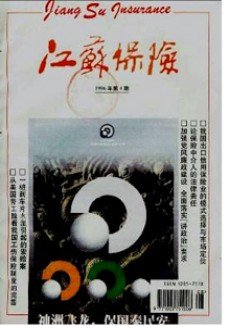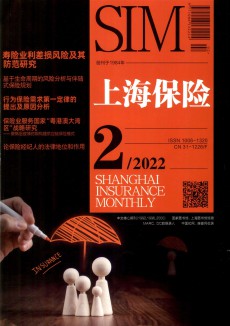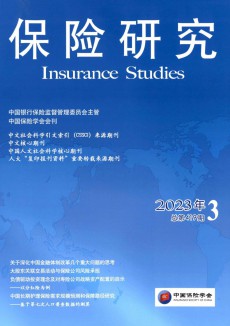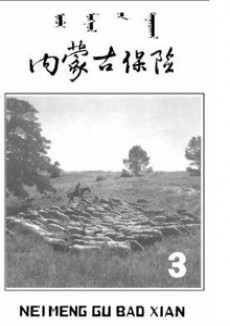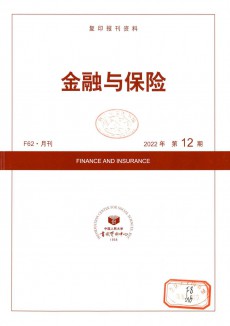保險碩士論文大全11篇
時間:2023-03-21 17:08:33緒論:寫作既是個人情感的抒發,也是對學術真理的探索,歡迎閱讀由發表云整理的11篇保險碩士論文范文,希望它們能為您的寫作提供參考和啟發。

篇(1)
從當前制度設計上看,我國初步形成了較全面的多層次的醫療保險體系,構建了較完備的醫療保障框架,低保群體“看病難、看病貴”問題得到一定程度的緩解。碩士論文,醫療保障。但在實踐過程中,低保群體最容易滑入醫療“貧困陷阱”,“因病致貧、因病返貧”現象也是屢見不鮮。碩士論文,醫療保障。
一、低保群體醫療保險的基本狀況及分析
現以豐城市原始調研數據為依據,分析我國低保群體的基本狀況及低保群體醫療保障體系中存在的問題。
1.調查基本情況與初步分析
我們共調查了豐城市100戶低保家庭,城市和農村各50戶。(1)年齡結構:低保群體多數是中老年人,60歲以上高達38%。說明低保群體老齡化問題相當嚴重,給國家帶來低保救濟和老人供養的雙重壓力。碩士論文,醫療保障。碩士論文,醫療保障。(2)致貧原因:致使他們成為低保戶的原因,主要是常年性的低收入;其次是其他原因,如家庭主勞動力早逝、下崗、家園遭受自然災害等;然后是多年重病和傷殘。(3)月人均收入:低保戶的月人均收入主要在100至300元之間,其中大部分來自政府發放的低保金及子女給予的贍養費。然而,這只能維持他們的基本生活,若遇到疾病風險,他們將陷入巨大困境,甚至失去基本的生活保障。(4)年人均醫療費用:在100戶被調查低保戶中,有一半以上的被調查者的年平均醫療費用在500元左右,超過四分之一的被調查者的年平均醫療費用超過1000元,其中有三戶超過5000元以上。
2.存在的問題:(1)醫療費用報銷比例低,難以解決低保群體“看病貴”的問題。在調查的100戶中,平均每年的醫療費用支出在1000元左右,而這些醫療費用支出是在城鎮基本醫療保險、新農合和城鄉療救助報銷之外的。據被調查的低保戶反映,其醫療費用的報銷比例在40%~60%之間。對于大部分的低保戶來說,這部分報銷之外的醫療費用是一個沉重的負擔,占其生活總支出的35%以上。(2)報銷范圍過小,只能在定點醫院才能報銷。報銷醫療費用的范圍僅僅局限于國家規定的醫藥目錄,很多疾病的相關治療藥物被排除在報銷范圍之外。低保戶普遍反映不住院就不能報銷醫療費用,而住院各項醫療費用又比外面一些診所貴,即使報銷了一些費用也不劃算。在豐城,定點醫院偏少,僅有豐城市人民醫院、豐城市中醫院以及豐城市紅十字會醫院三家是醫療保險定點醫院,對于地理位置相對偏僻的地方,特別是農村地區來說,“看病難”問題十分突出。碩士論文,醫療保障。(3)報銷手續過于繁雜,報銷花費時間過長。調查發現,低保戶對現行醫療保險體制不滿意的一個主要原因是手續太多、程序太繁,他們希望政府能簡化手續,減少程序。比如,豐城市的醫療救助首先要向居(村)委會申請,然后通過鄉鎮、縣市民政以及醫保、新農合等相關部門的審核,手續繁瑣,審批時間長達一個多月。
二、政府為低保群體采購商業醫保的政策設計
1.模式借鑒:(1)江蘇江陰模式:自01年起江陰的農村醫保就由太平洋保險公司江陰支行管理,實行27元保費,2萬元補償的方案,太保可以從醫保基金中提取10%的管理費,征繳、管理、監督三權分立。(2)河南新鄉模式:自04年起河南新鄉的新農合作就委托中國人壽保險公司新鄉分公司管理,當時國壽提取的管理費為保費的1%,07年為2%。2008年新鄉開始將城鎮居民和職工基本醫保委托給壽保公司經辦或部分經辦。
2.政策設計及建議:(1)政府通過招標方式引入商保競爭機制,與實力雄厚,專業化水平高的保險公司合作,將低保群體的醫療保險循序漸進地委托給商保公司管理,由商保公司根據各地的實際情況采集原始數據并通過精算確定保費率及補償額。(2)實行“征、管、監”分離制度,政府負責醫保方案制定和出臺相關政策等工作;民政部門負責資金籌集,向保險公司支付保費和監督等工作;保險公司以第三方管理者的身份,受托承辦低保群體醫保運行管理中的報銷,結算和審核等工作。(3)政府規定保險公司可以從醫保基金中提取1%—10%的管理費用,具體比例由各地根據實際情況確定。(4)政府將低保群體的醫保基金劃撥到保險公司專項賬戶,采用信托方式運作,實現醫保基金和政府其他資金的有效隔離。保險公司按照收支兩條線統一管理,實現專項資金和分公司其他費用分開核算。
三、政府為低保群體采購商業醫保的政策論證
1.政策成本分析:09年我國低保總人數為7107萬人,根據豐城市的調查數據,低保戶期望的醫療費用報銷比例為80%,每人平均每年醫療費用支出約為1000元,則
總成本:71.07億元
低保戶期望報銷額:56.856億元(71.07×80%)。
其中:城鎮基本醫保和新農合負擔額:28.428億元(56.856×50%)(50%為全國平均水平)
其他補充,如城鄉醫療救助等負擔額:17.0568億元(56.856×30%)
商業醫保負擔額:11.3712億元(56.856×20%)
即政府實行為低保群體采購商業醫保的政策,共需籌集資金11.3712億元,此即為其政策成本。
2.政府財政可承受性分析
低保戶自繳保費:0.94547億元(城市2347.7萬人×20元/人=0.46954億元;農村4759.3萬人×10元/人=0.47593億元)。
政府因引入為低保群體采購商業醫保政策后,可以精簡政府機構,減少工作人員,節省財政經費:按河南新鄉模式,工作人員由544人減少到50人,財政經費由千萬以上較少到不過150萬元,可測算節省額至少有2億元。
政府因引入為低保群體采購商業醫保政策后,可以降低不合理的醫療費用支出:按江蘇江陰模式,不合理的醫療費用從一般水平的30%下降到了15%,可以測算節省額至少有1千萬元。
其他,如社會慈善捐助:1億元。碩士論文,醫療保障。
則政府財政還需負擔7.32573億元。
可設計,中央財政負擔60%:4.395438億元;地方財政(省級)負擔40%:2.930292億元。
《醫藥衛生體制改革近期重點實施方案(2009—2011年)》測算2009—2011年各級政府投入8500億元。因而政府因引入為低保群體采購商業醫保政策后由政府財政負擔的7.32573億元,可以得到確實保障。
參考文獻:
篇(2)
企業管理思想進步到當下的階段,很難想象一家沒有上馬企業資源計劃ERP(Enterprise Resource Planning)或SAP(Systems Applications and Products in Data Processing)的公司是如何將物資資源管理(物流)、人力資源管理(人流)、財務資源管理(現金流)、信息資源管理(信息流)等集成一體化,進而推進生產、營銷、供應、人力、資金等業務互相融合而順暢運轉的。當今企業在信息化方面面臨的問題不是爭論ERP的必要性,也不是討論ERP的可行性,而是糾結于對ERP產生的海量數據如何進行進一步的收集、加工、處理。因為收集的數據多到無法甄別哪些是對決策有效的。
企業建立一套旨在全方位提升管理廣度和深度的管理信息系統是必需的:利用統一規劃的數據集成,以全面預算為主導,以產品生命周期管理為核心,以資金為主線,整合財務、人事、營銷、科研、生產等管理職能,重組優化業務流程,連接信息孤島,建立關鍵內部控制點,極大改善組織內部的信息不對稱,大幅降低管理成本,有效地防范和控制風險。但是,國內應用現狀是大部分企業正在運行的管理信息系統主要功能仍舊停留在處理大量的日常業務流程上,僅實現了中層管理的功能,并未上升到支持決策的高度。本文嘗試通過對決策支持系統(Decision Support System,以下簡稱“DSS”)運行原理、特點和功能的闡述,結合企業實際,充分利用已成熟運行的通用ERP并以此為基礎,模擬建立DSS的實施方案。
一、DSS的原理、特點和功能
20世紀70年代中期,美國麻省理工學院的米切爾?S?斯科特(Michael S.Scott)和彼德?G?W?基恩(Peter G.W.Keen)首次提出了“DSS”一詞。DSS通過數據、模型和知識,以人機交互方式進行半結構化或非結構化決策的計算機應用系統,為決策者提供分析問題、建立模型、模擬決策過程和方案的環境,調用各種信息資源和分析輔助決策工具,幫助決策者提高決策水平和質量(張茜,2006)。DSS是管理信息系統(Management Information System,MIS)向更高一級的發展,標志著利用計算機與信息支持決策的研究與應用進入了嶄新的階段,并形成了決策支持系統新學科(王劍東,2003;萬林,2008)。
DSS的特點體現在:(1)DSS的交互性表現在通過管理者同系統之間的多次對話,使決策得以完成;(2)DSS解決的問題屬于半結構化或非結構化問題;(3)系統具有專門的結構存儲和研究備用的模型及方法,提供模型的比較、聯結和合成的功能;(4)DSS只是起輔助決策的作用,并不完全取代管理者的判斷,應當讓管理者處于主動地位;(5)DSS應當便于學習、使用和修改,因而要對用戶的需求進行動態性的分析,做到及時完善DSS的各種功能(遲殿委,2008;徐強,2008)。DSS的應用原理體現了決策支持系統本質的演變:DSS初期是利用數據資料(數據庫DB) 和模型資源(模型庫MB)支持決策,發展到IDSS利用知識資源 (方法庫MEB)和模型資源(模型庫MB)結合支持決策,再到利用數據資源(數據倉庫DW)支持決策。這樣,決策支持系統概念就更明確為:針對決策問題,利用決策資源(數據、模型、知識等)(侯少然,2010)進行組合和集成,建立解決方案;通過方案的模型計算、知識推理、多維數據分析以及方案的修改,逐步逼近解決決策問題的系統。
數據資源(數據庫與數據倉庫)、模型資源和知識資源在網絡上都是共享資源。決策支持系統就在于如何有效地利用這些決策資源,針對決策問題,把決策資源有機地組合成解決方案,既可以建立多個方案,又可以修改方案,再通過大量的計算或推理,最終達到支持決策的效果(張胤杰,2009)。DSS所實現的功能主要表現在:(1)管理并隨時提供與決策問題有關的組織內部和外部消息;(2)收集、管理并提供各項決策方案執行情況的反饋信息,例如訂貨單、合同執行進程、物料供應計劃的落實情況、生產計劃的完成情況等;(3)能以一定的方式存儲和管理與決策問題有關的各種數學模型,例如定價模型、庫存控制模型與生產調度模型等;(4)能夠存儲并提供常用的數學方法(張世芳,2006),例如回歸分析方法、線性規劃、最短路徑法等;(5)數據、模型與方法能容易地修改和添加,例如數據模式的變更、模型的連接或修改、算法的修改等(王劍東,2003;孫艷勝,2007);(6)具有方便的人機對話和圖像輸出功能,能滿足隨機的數據查詢要求,回答“if…what…”之類的問題(馮罡,2003;孫艷勝,2007)。
二、DSS的總體框架和表現方式
DSS的總體框架是:將來源于不同子系統、不同管理軟件的數據收集于數據集成平臺或數據倉庫,選取各項決策分析主題的關鍵指標,注入事先建立的數學模型,最終生成可進行人機對話、不斷修改決策變量的結果。其系統規劃包含以下幾個方面:
1.數據來源:可讀取多種格式(如Excel、Access、以Tab分割的txt和固定長的txt等)的文件,同時可讀取關系型數據庫 (對應ODBC)中的數據。使用報表管理平臺進行所需數據報表的上傳收集,財務數據來源于財務核算軟件,經營和項目數據來源于合同管理、PDM產品設計、生產作業管理軟件等,人力資源數據來源于人員信息、薪酬統計軟件等,其他未能進入系統的數據可考慮通過平面文件的形式進行采集。通過數據整合平臺建立數據倉庫,裝載來源于各個系統的數據,包括歷史數據的一次性裝入、日常發生數據的定時抽取。
2.分析主題:構成決策支持系統的重要分析內容,按照管理者的思維邏輯建立跨流程、跨職能的主題和分析路徑,對重要經營管理問題和要素進行深入分析,及時發現影響企業經營和管理的問題所在。考慮初步建立財務主題、營銷主題、項目主題、關鍵指標等幾部分。
3.決策模型:決策模型是決策支持系統的重要分析基礎,為企業管理者提供輔助決策的科學管理工具,包括成本預算模擬、現金流模擬預測、盈利模擬預測等。
4.門戶表示:是專門為企業管理者和決策者設計的觀察企業的窗口,提供整個決策支持系統的展示界面,包括智能分析、模擬預測、績效管理等多種展現形式與門戶集成。所需要的輸出被顯示出來時,進行定型登錄,自動將所要的列表、視圖和圖表顯示出來。
三、DSS的財務實施方案
DSS的財務主題部分是本文討論的重點,其實施方案立足于從時間跨度(年度、季度、月度)、項目類型(研究、開發、制造)、決策深度(作業層、戰術層、戰略層)等不同維度進行趨勢分析、結構分析、因素分析,通過這樣一個路徑完成由低端財務分析向高端輔助決策支持的過渡。實施方案的對象包括:收入成本分析(收入構成、趨勢、預算執行、費用趨勢、費用構成等)、利潤分析(利潤因素、敏感性)、資金分析(資金協調性、貸款、融資成本)和綜合評價(經營指標考核、五能力綜合評價)。
實施方案必須注入以下因子:分析范圍(集團內部關聯方、集團外部競爭對手、國外競爭對手等);分析角度(全周期項目預算、年度財務預算、市場經營預測、人力資源投入等);分析指標(絕對數、相對數,橫向比較、縱向比較);數據來源;分析周期;分析內容。
四、財務決策模型的導入
決策支持系統財務應用的最終目的聚焦在綜合評價,無論是討論重大項目的取舍還是輔助企業的整體決策,主要包括兩部分內容:經營指標考核和五能力綜合評價。
目前大部分企業對財務管理軟件的使用,依舊停留在賬務處理階段,軟件本身對收集的數據不加工、不處理、不分析。如果從最基礎的財務指標分析入手進行適當改進,那么對于決策層而言可增強財務數據的可理解性和拓展性,對于財務人員而言可提高操作的可行性,都是受益匪淺的。財務分析包括盈利能力(收益力,總資產報酬率、凈資產收益率、主營業務利潤率、銷售凈利潤率、成本費用利潤率)、償債能力(安定力,流動比率、速動比率、資產負債率、利息保障倍數、所有者(股東)權益比率)、運營能力(活動力,總資產周轉率、固定資產周轉率、流動資產周轉率、應收賬款周轉率、存貨周轉率)、發展能力(成長力,主營業務收入增長率、資本積累率、總資產增長率)和生產能力(生產力,人均主營業務收入、人均凈利潤、人均資產總額)五部分(即五力),通常以完整、真實、及時的財務數據為起點,借助不同的財務指標進行詮釋。大部分企業通過對正在運行的財務管理信息系統進行適當的改進,就足以在完成指標計算的基礎上提供簡單的財務分析報告。
計算完成后,進一步引入由哈佛大學商學院邁克爾?波特(Michael Porter)于1979年提出的,現今被廣泛應用于全球企業競爭戰略決策的五力模型,該五力模型對決策層更加清晰、透徹地了解企業的經營業績和發展前景的幫助是顯著的。
綜上所述,決策支持系統作為新興的信息技術,能夠為企業提供各類決策信息以及許多商業問題的解決方案,從而減輕了管理者從事低層次信息處理和分析的負擔,使得他們專注于更需要決策智慧和行業積累的工作,實現了決策質量和效率的提升(侯少然,2010)。雖然DSS在國內大部分企業的開發與應用依然處于初級階段,決策本身是復雜的、變化的、綜合的,但以ERP為基礎對DSS的設計和實現是可行的,成功是可以預見的。
(作者為CPA、會計師、上海財經大學碩士研究生)
參考文獻
[1] 高洪深.決策支持系統(DSS)理論與方法(第4版)[M].北京:清華大學出版社,2009.
[2] 潘飛,文東華.實證管理會計研究現狀及中國未來的研究方向――基于價值管理視角[J].北京:會計研究,2006(2).
[3] 陳文偉.決策支持系統及其開發[M].北京:清華大學出版社,2004.
[4] 徐強.企業綠色管理決策影響因素研究[D].大連海事大學碩士論文,2008-03-01.
[5] 馮罡.企業整合管理能力評價和提升[D].北京:沈陽工業大學碩士論文,2003-03-07.
[6] 孫艷勝.基于B超數據心臟病輔助診斷系統[D].長春:吉林大學碩士論文,2007-04-01.
[7] 侯少然.企業物流資源協調優化決策支持系統研究[D].天津大學碩士論文,2010-06-01.
[8] 張茜.公共危機管理系統研究[D].武漢理工大學碩士論文,2006-10-01.
[9] 王劍東.基于C/S結構的備品配件管理系統研究與應用[D].保定:華北電力大學(河北)碩士論文,2003-12-26.
[10] 遲殿委.基于數據挖掘的決策支持系統的研究與實現[D].南昌大學碩士論文,2008-06-30.
篇(3)
在《最高人民法院公報》公布的裁判文書中,以下兩個案例最具有代表意義:(一)楊某訴某公司人身損害賠償糾紛案①。(二)李某訴某公司、某學校人身損害賠償糾紛案②。人民法院判決認定,在案件(一)中,某公司職工在工作中違規作業,從高處拋擲鋼管,將正在現場工作的楊某頭部砸傷,導致重度顱腦外傷、外傷性尿崩癥等四級傷殘。在案件(二)中,實習生李某被實習地的機械設備壓傷右手,造成右手第2-5指完全斷離,經過治療,接上了食指和中指,經司法鑒定,其右手傷殘等級相當于道路交通事故九級傷殘。
二、案件的爭議焦點
案件(一):因用人單位以外的第三人造成勞動者人身損害,構成工傷的,勞動者在獲得用人單位工傷保險賠償后,又向侵權人提起人身損害賠償訴訟,請求判令侵權人承擔民事賠償責任的,是否應當予以支持。案件(二):(1)實習生在實習單位工作中,在工作時間、工作場所因工作原因受到傷害的,自身存在一般性過錯,是否能減輕實習單位的賠償責任;(2)學校應就實習生在實習中的安全和權益依法提供必要的保障,學校未對實習單位盡到必要督促義務的,是否應根據其過錯程度對實習生的損害后果承擔相應法律責任。
三、勞動關系中人身侵權的認定標準
勞動關系中的人身損害賠償案件作為一種人身侵權的案件,侵權行為、損害后果、因果關系、行為人的過錯都是需要證明和認定的事實。(一)存在侵權行為責任產生的基礎是侵權行為,侵權行為既包括因行為人的過錯而導致的侵權行為,還包括違反法律規定的義務而產生的責任。因此,侵權行為是指民事主體違反民事義務,侵害他人合法權益,依法應承擔民事責任的行為。勞動關系的存在是產生法定責任的前提。在案件(一)中,用人單位以外第三人違規作業是造成楊某受傷的直接原因。在案件(二)中,某公司對李某沒有盡到安全保障義務導致李某受傷。(二)當事人存在過錯在人身損害賠償案件中,按照一般侵權賠償的理論,侵權人承擔的是過錯責任,即侵權人根據其過錯程度來承擔相對應的賠償責任,因此過錯認定至關重要。在案件(一)中,某公司職工在工作過程中違規作業,從高處拋擲鋼管,將正在現場工作的楊某頭部砸傷,導致重度顱腦外傷、外傷性尿崩癥等,經鑒定為四級傷殘,很明顯某公司違規作業,存在過錯。在案件(二)中,李某作為具有完全民事行為能力的成年人,又經過相關的專業培訓,對設備的操作應具有一定的認知,但是李某沒有遵循正確操作規程,在無專業人員陪同下自行更換模具,對損害后果的發生負有一定的過錯,并且李某尚在實習期沒有獨自操作機器的能力,公司應當安排但沒有安排師傅在旁指導,因此某公司對李某受傷也存在過錯。(三)人身損害結果損害結果,是行為客觀上對他人的財產或人身造成的損害。損害結果既包括財產損失,也包括人身損失,如死亡、人身傷害、精神損害等。在案件(一)中,楊某被砸傷頭部,導致重度顱腦外傷、外傷性尿崩癥等損傷。在案件(二)中,原告李某在更換模具過程中被機器截斷其右手第2-5指。(四)因果關系因果關系,即原因在先,結果在后,二者的關系屬于引起和被引起的關系,即一種現象在一定條件下必然引起另一種現象的發生,這兩種現象之間的聯系,就稱為因果關系。在案件(一)中,楊某的損害是因為某公司員工的違規作業造成的,很明顯受害人的損害與加害人的損害行為存在必然的因果關系。在案件(二)中,李某操作不當受傷,雖然師傅在場也不一定能避免,但與某公司未盡到安全保障義務還是有一定因果關系。
四、賠償問題
一方當事人簽訂正式勞動合同,在工作中受到人身侵害,滿足工傷條件的既可以請求工傷賠償,也可以請求第三人賠償。工傷賠償,是基于勞動保險關系而產生;而工傷事故又被評價為民事侵權行為,因此就產生了人身侵權損害賠償法律關系。兩種法律關系并存,兩種賠償方式并存,受害人可以一并行使。實習生實習期間受到人身損害的,可以請求實習單位和學校賠償。實習單位對在其工作場所工作的人員都負有安全保障義務,因此對實習生遭受的損害負有一定的賠償責任。實習生雖然在實習單位工作但其身份仍然是學生,被學校所管理,是在執行學校的安排,因此學校對實習生的損害也負有一定的責任。
[參考文獻]
[1]楊建軍.合同履行中的人身侵權及民事責任[J].環球法律評論,2009(1).
[2]姜耀輝.實學生人身傷害的法律保障研究[D].中南大學碩士論文,2013.
篇(4)
2016年招生簡章
浙江大學是教育部直屬、省部共建的普通高等學校,是首批進入國家“211工程”和“985工程”建設的若干所重點大學之一。浙江大學前身求是書院成立于1897年,為中國人自己最早創辦的新式高等學府之一。1952年,在全國高等院校調整時,曾被分為多所單科性學校,部分系科并入兄弟高校。1998年,同根同源的浙江大學、杭州大學、浙江農業大學、浙江醫科大學合并組建新的浙江大學。經過一百多年的建設與發展,學校已成為一所基礎堅實、實力雄厚,特色鮮明,居于國內一流水平,在國際上有較大影響的研究型、綜合型大學。
為幫助在職人員進一步適應國家經濟與社會發展、法治建設需要,幫助學員掌握更加堅實的法學理論基礎,提高運用法學理論解決實際問題的能力,浙江大學光華法學院決定在學院本部開設憲法學與行政法學、民商法學、經濟法學、刑法學、國際法學專業研究生課程班。
一、招生對象與條件
參加同等學力申請碩士學位在職研究生班學習的在職人員,需符合下列條件與要求:
1. 堅持四項基本原則,熱愛祖國,遵紀守法,品行端正,身體健康;
2. 具有本科及以上學歷, 欲申請碩士學位者需在取得學士學位滿一年后方可報名。
二、報名方式及時間
1. 報名時間:即日起報名,每班人數為60名;
2. 報名地點:浙江大學光華法學院2號樓112室(杭州市之江路51號),郵編:310008;
3. 報名時應當提交下列材料:(1)學歷證書、學士學位證書原件及復印件各1份;(2)1寸免冠照片和2寸免冠照片各2張;(3)報名登記表(需加蓋單位公章)。
4.上課地點:a,、杭州市之江路51號浙江大學之江校區 (杭州班)
b、溫州市浙江工貿學院1號樓(溫州班)
三、錄取事項
1. 錄取審查:由浙江大學光華法學院和浙江大學研究生院共同進行錄取資格審查;
2. 正式錄取及學費收取:凡審查合格者,發入學交費通知。學員依據通知規定,入學前完成交費。
四、學習年限及收費
1. 學習年限兩年。按規定學時面授,充分利用在職人員業余時間;
2. 學費:21000元,資料費1000元。(民商法學方向)
學費:21000元,資料費1000元。(公司與金融法方向)
學費:21000元,資料費1000元。(刑法學方向)
學費:21000元,資料費1000元。(經濟法學方向)
五、主要專業方向及課程
民商法學:法學前沿(含刑事法學)、民法總論、債權法學、商法學(金融法、票據法、公司法、保險法等)、民事訴訟與仲裁法、國際法學、碩士生英語、民商法專題、民事法律與特別法、法律行為專題、刑事法專題、行政法專題、商事案例研習、服務合同專題、侵權案例研習、票據法專題。
公司與金融法:法學前沿、民法總論、債權法學、商法、金融法、票據法、公司法、股權投資法、證券期貨法、保險法、銀行法、碩士生英語、投資基金法、信托法、國際金融法、金融刑法、行政法(金融監管)、房地產法、民事訴訟與仲裁、貨幣金融專題、證券投資專題。
刑法學:法學前沿、碩士生英語、法學方法論、刑法原理、各罪研究、民法總論、國際刑法、證據法學基礎理論、犯罪學專題、刑事訴訟法專題、刑事偵查與司法鑒定專題、行政法專題等。
經濟法學:法學前沿、碩士生英語、法學方法論、經濟法專題、商法專題、行政法專題、民法專題、刑法專題、訴訟法專題、知識產權法研究、金融法研究、國際經濟法、勞動法學、環境法研究、財稅法、企業法等。
六、結業與學位申請
1. 進修學員按專業培養計劃完成課程學習,考核或考試合格,發給浙江大學研究生課程結業證書;
2. 獲得浙江大學研究生課程結業證書,具有學士學位并通過全國以同等學力申請碩士學位外語統一考試與法學綜合課考試者,通過浙江大學以同等學力申請碩士學位資格審查,進入碩士論文階段,碩士論文答辯通過,授予浙江大學法學碩士學位。
【聯系電話】 010-51656177 010-51651981
篇(5)
【中圖分類號】F752
一、服務貿易的定義
服務貿易是一國的法人或自然人在其境內或進入他國境內向其他締約方提供服務的貿易行為。烏拉圭回合協議把服務貿易描述為:(1)從一締約方境內向任何其他締約方提供服務;(2)在一締約方境內向任何其他締約方消費者提供服務;(3)一締約方在其他任何締約方境內提供服務的商業存在而提供服務;(4)一締約方的自然人在其他任何締約方境內提供服務。事實上這里指的是國際服務貿易。服務貿易有四種提供服務的交易方式:跨境交付、境外消費、商業存在和自然人流動。
二、服務貿易的統計依據及范圍
我國的服務貿易統計依據的是2012年8月新修訂的《國際服務貿易統計制度》,該制度采納了聯合國等六大國際組織共同編著的《國際服務貿易統計手冊》中所建議的服務貿易統計基本框架,統計范圍主要包括服務進出口統計、外國附屬機構服務貿易統計和自然人移動統計三個方面。在具體操作上,以居民與非居民間的服務貿易和通過外國附屬機構實現的服務貿易兩條主線進行服務貿易統計。而對于自然人移動統計,因其范圍難于界定以及可行的統計指標有限,僅作為服務貿易統計的次要組成部分。服務貿易統計類別包括運輸服務、旅游服務、通信服務、建筑服務、保險服務、金融服務、計算機和信息服務、專有權利使用費和特許費、咨詢、廣告宣傳費、電影音像、其他商業服務。根據不同服務項目的業務特點,《國際服務貿易統計制度》規定,服務貿易統計數據采集的方法包括全數調查、抽樣調查、重點調查、典型調查和科學測算,并利用行政記錄等資料進行統計。
三、我國服務貿易現狀分析
隨著我國改革開放的不斷深入,科技發展的不斷進步,我國服務貿易發展迅速,新的服務業不斷出現,服務項目眾多,國際服務貿易交換形式各異,貿易規模迅速擴大,服務貿易在國民經濟中的地位和作用日益凸顯。本文僅通過服務貿易進出口數據加以分析利用。根據2015年中國商務部和國家外匯管理局的中國服務貿易出口分項目情況統計數據,旅游、運輸、其他商業服務一直是中國服務貿易出口的三大主要類別,咨詢服務發展較快,2012年起已超過其他商業服務。從服務貿易進出口總量看,2014年中國服務進出口達6 043億美元,同比增長12.6%,占世界比重6.3%。其中:服務貿易出口2 222億美元,同比增長7.6%,占世界比重4.6%;服務貿易進口3 821億美元,同比增長15.8%,占世界比重8.1%。服務貿易進口遠遠大于出口,逆差1 599億美元。
服務貿易進出口快速發展,平均增速均達到17.14%。2014年的服務貿易進出口額6 043億美元與2000年660億美元相比,增加了5 383億美元,年平均增速達17.14%。其中:服務貿易出口額2014年2 222億美元,較2000年301億美元,增加了1 921億美元,年均增速達15.34%;服務貿易進口額2014年3 821億美元,較2000年359億美元,增加了3 462億美元,年平均增速達18.40%;服務貿易進口增速大于出口增速3.06個百分點。從服務貿易各類別的增速看,除通信服務為7.04%,其余呈現2位數的增速,其中增速排前三名的是咨詢、金融及計算機和信息服務,分別為35.34%、33.33%和30.89%。
(一)長期占據服務貿易主導地位的傳統服務貿易格局逐步被打破
中國傳統服務業――旅游、運輸、建筑和其他商業服務長期是中國服務貿易的重要組成部分,2012年以來,咨詢服務的增長速度遠遠超過了建筑服務和其他商業服務。2012至2014年排在前三位的旅游、運輸和咨詢服務的進出口總額分別占服務貿易總量的70.18%、69.74%和70.39%,已經打破了傳統旅游、運輸和建筑服務占主導地位的格局。2012~2014年旅游服務進出口總額分別占服務貿易總量32.3%、33.4%和36.7%,呈逐年增長的態勢,主要是受中國居民“出境游”持續升溫的影響。
(二)服務貿易進出口逆差不斷加大
從服務貿易總量看,進出均快速增長,但服務貿易進口增速大于出口增速,服務貿易進出口連年出現逆差,從2000年的逆差57.1億美元增加到2014年的1 599億美元,呈逐年加大態勢。特別是從2000年以來,運輸、旅游、保險、專有權利使用費和特許費進出口差距加大,進口服務遠大于出口。
(三)服務貿易結構不合理
從各服務貿易構成類別來看,進出口總量較大的仍是旅游、運輸、建筑這些勞動密集型服務產業,通信、保險、金融、計算機與信息服務、專有權利服務、咨詢等技術密集和知識密集的行業,盡管有較高增速,但目前這些行業規模偏小,仍處于較低發展水平。
(四)從服務貿易類別分析,存在發展不平衡現象
2014年與2000年相比,服務貿易進出口總量增加5 383億美元,其中旅游服務進出口凈增加最大為1 923.7億美元中進口增加1 516.9億美元,出口增加僅為406.8億美元;運輸服務凈增加1 204.3億美元中進口增加858億美元,出口增加僅為346.3億美元,其他像通信、保險、金融、專用權利使用費和特許費、電影音像等均是進口大于出口。只有咨詢服務的凈增加額中出口425.4億美元遠大于進口256.6億美元,建筑、計算機和信息服務、廣告宣傳和其他商業服務的凈增加值出口略大于進口。
主要參考文獻:
篇(6)
關于財產的分割,包括有形財產和無形財產。有形財產的含義基本上沒有爭議,關鍵是無形財產。我國婚姻法第十七條規定了知識產權的收益,當然也應包括對知識產權的分割,其他的無形財產還有股權,債券,票據,保險等,這些也沒有爭議。還有人認為謀生技能也算是財產[1],應當作為夫妻共同財產進行分割,就未免有些牽強。謀生技能作為一種勞動能力,它依附于人身,并且很難用金錢衡量,用馬克思勞動力價值的觀點,勞動力是沒有價值的[2],它只會在勞動中創造價值。所以,把謀生技能也作為財產進行分割,是對財產范圍的不恰當的擴大。
很多人認為夫妻離婚時分割的僅僅是夫妻共同所有的財產[3],我認為不然。誠然,“離婚時,應分清個人財產、夫妻共同財產和家庭共同財產”[4],但是這并不意味著僅僅分割共同財產,因為即使約定夫妻婚后財產各自所有,仍然有家務補償,分擔子女撫養費等問題,也就是說,個人財產在離婚的時候并不必然全屬于個人,還有可能分出來給子女或者原來的配偶,不應否認,這也算是對個人財產的分割。所以,結論是,夫妻離婚時分割的不僅僅是夫妻的共同財產,還包括一部分夫妻各自所有的財產。
此外,債務的清償、子女撫養費的分擔、家務補償、經濟幫助和損害賠償也是財產分割制度的內容,因為這些都涉及到各方最終所分得的財產的數量。我國婚姻法第41條、最高人民法院關于適用《中華人民共和國婚姻法》若干問題的解釋(二)第23條,第25條對夫妻債務的清償進行了規定,確屬個人債務的,由個人清償,共同債務共同連帶清償[5]。婚姻法第37條、第40條、第42條、第46條對離婚后子女撫養費的負擔、家務補償、經濟幫助、損害賠償分別作了規定。限于篇幅,在此不一一分述。
總之,法律和司法解釋的有關處理夫妻財產的具體規定,與人民法院處理夫妻財產的原則——男女平等原則、保護婦女兒童的合法權益原則、照顧無過錯方原則、尊重當事人意愿原則、保證生產和生活的正常進行原則——一起,構成了我國婚姻法的夫妻離婚后的財產分割制度。
2、我國夫妻離婚后的財產分割制度存在的問題
對我國婚姻法的夫妻離婚后的財產分割制度的內容有了了解后,下面簡單探討一下其中存在的問題。
第一個是照顧無過錯方原則的存廢問題。照顧無過錯方原則,簡稱照顧原則,很多人贊成保留[5],也有學者主張廢除,認為照顧原則沒有存在必要[6]。我同意后一種觀點,照顧原則應該廢除。但與孫若軍認為“過錯不易確定,照顧原則難以落實”,因而主張廢棄該原則不同,本人覺得婚姻法已經規定了離婚損害賠償制度,有過錯方要承擔損害賠償,再保留照顧無過錯方原則沒有必要。紀要是有過錯一方承擔損害賠償,又要在此基礎上對另一方進行照顧,也有違公平原則,因為過錯者已經承擔了賠償責任,不應再承受更多的不利。
第二個問題是家務補償制度存在的問題。這一問題在張素華女士“謀生技能作為夫妻共同財產的法理分析”一文中有明確論述,即婚姻法第40條家務補償的限定條件是“夫妻書面約定婚姻關系存續期間所得的財產歸各自所有”,在此情形下才能要求家務補償,“如果雙方約定僅針對婚前財產,或者約定婚后財產為共同所有的,則不適用該條的規定”[7]。張素華認為這樣的限定是不合理的,“該條件的限制使得夫妻一方很難行使家務補償權”[8]。本人同意這種觀點。
結論
通過以上論述可以看出,我國婚姻法關于夫妻離婚后的財產分割的規定是比較完善的,并且可以構成一個系統的離婚財產分割制度。但是,這一制度中也存在著問題,存在著爭論。
參考文獻:
[1]張素華,謀生技能作為夫妻共同財產的法理分析,中州大學學報,2007年1月。
[2]馬克思,《資本論》第五章:勞動過程和價值增殖過程。
[3]劉洪,從現行的離婚財產分割來看我國夫妻財產制度的完善,華東政法學院碩士論文,p17,2001。
[4]同上,p16。
[5]蔣婉清,離婚精神損害賠償制度之研究,中國政法大學碩士學位論文,p9,2005;劉洪,從現行的離婚財產分割來看我國夫妻財產制度的完善,華東政法學院碩士論文,p38,2001;王曉云,析離婚夫妻共同無形財產之股權分割,中國政法大學碩士學位論文,p28,2006。
[6]孫若軍,論離婚損害賠償制度,法學家,2001年第5期。
篇(7)
申請碩士學位課程 招生簡章
經濟的全球化,使得金融業在國家經濟生活中的重要性日益上升,也使公司與金融法成為各國法律體系中最重要的組成部分。金融業是一個以規則運行為特征的特殊產業。實踐證明,經過高素質法律訓練的人尤其適應該行業的競爭與生存,因此,法律人往往會從事該行業工作,已經具備其他專業知識背景的人員,如實現與法律專業知識的復合,成為復合型高端人才,則優勢凸顯。具備傳統法律知識的人員,對于專業很強的公司與金融法律也有知識轉型、更新和提升的需要。
浙江大學法學院為應對這種社會需求,特開設公司與金融法碩士課程班,綜合浙江大學法學院和國內高校、研究機構及金融管理實務部門的優質資源,為學員提供碩士層面前沿熱點國內外公司與金融法律知識,使學員的公司與金融法理論和實務能力得到跨越式提升。
【課程對象】
公司、證券、銀行、保險、信托、期貨、擔保、貸款公司等相關行業人員;公安、法院、檢察院、律師事務所及仲裁委等公司與金融法律從業者;政府金融辦、人民銀行等“一行三會”監管官員。
專業背景不限,免試入學。
【課程設置】
法理學、法學前沿、碩士生英語、民法總論、物權法學、債權法學、商法、金融法、票據法、公司法、股權投資法、證券期貨法、保險法、銀行法、投資基金法、信托法、國際金融法、金融刑法、行政法(金融監管)、房地產法、民事訴訟與仲裁、貨幣金融專題、證券投資專題。
富有特色的實戰案例教學,理論與實踐相結合,知識與能力并進。
【學習時間】
1年半,雙休日學習。
【證書頒發】
經考核合格后頒發浙江大學同等學力申請碩士學位人員課程班結業證書。符合條件,通過考試和碩士論文答辯可獲得浙江大學法學碩士學位。
【課程費用】
學費:21000元。
書本費:1000元。
教學地點:浙江大學之江校區
【聯系電話】 010-51656177 010-51651981
篇(8)
人力資本理論形成于20世紀60年代,主要代表人物是美國著名經濟學家舒爾茨。他強調,從經濟發展的角度看,人的知識、技能和健康等人力資本的提高,對經濟增長的貢獻遠比物質資本和勞動力數量的增加重要。
一、烏魯木齊人力資本投資現狀
2009年,烏魯木齊市戶籍人口達241.19萬人,少數民族占到27.47%,其中男性人口124.78萬人,占51.7%;女性人口116.41萬人,占48.3%,性別比為107:100(以女性為100)。全年出生人口1.91萬人,出生率為8‰;死亡人口0.74萬人,死亡率為3.11‰;全年凈增人口1.17萬人,自然增長率為4.89‰。烏魯木齊從業人口占總人口的比重見圖1。
(一)烏魯木齊人力資本教育及培訓情況
1.教育經費投入不足
《教育規劃綱要》明確提出,2012年國家財政性教育經費支出占國內生產總值比例要達到4%。而從表1來看,烏魯木齊教育支出占GDP的比重在2008年僅為1.77%,低于全國2.90%的平均水平,籌措嚴重不足。2008年在西部省會城市教育支出占GDP比重的排名中,烏魯木齊排名第9,遠低于《教育規劃綱要》明確規定的4%。
2.高等教育入學率較低
截至2009年年末,烏魯木齊共有各類學校623所,各類學校在校生達625816人,其中,普通高校在校生13.03萬人,增長12.03%(1995年為基年);中等專業在校生8.84萬人,增長7.84%;普通中學在校生25.66萬人,增長24.66%;小學在校生19.28萬人,增長18.28%。從表2可以看出,烏魯木齊的普通高中和高等教育規模逐年擴大,同時也反映出中等專業教育和高等教育的規模增幅態勢。相比小學和普通高中的入學情況,中等專業教育和高等教育的增幅較弱,中等專業教育發展速度較慢。
3.教育培訓供給形式單一
2009年安置就業5.93萬人,創建充分就業社區65個,啟動了全國創業型城市創建工作,開展了大中專學生示范創業培訓和5個重點片區就業人員職業培訓,完成各類培訓8.7萬人。發放小額擔保貸款9162萬元,帶動6847人實現就業再就業。但培訓仍然存在許多問題:辦學規模小,辦學范圍窄,辦學層次低,財力不足,特色不明顯;政府對社會辦學重視不夠,鼓勵、扶持力度不強。
(二)烏魯木齊科研開況
2009年末,烏魯木齊深入開展國家知識產權示范城市創建活動,60項科技專利成功獲國家和自治區科技獎勵,專利申請量和授權量達到1065件和631件。安排應用技術研究與開發資金3440萬元,重點支持了120項科技計劃項目和重大專項,帶動社會科技投入2.9億元,但總體比較,科研開發能力較弱。
(三)烏魯木齊人力資本的遷移情況
據統計,2009年烏魯木齊遷入58715人,遷出44009人。1990年烏魯木齊遷入34146人,遷出29419人,20年來烏魯木齊遷入人口增加了71.95%,其中跨省流動人口增加了49.59%。流動人口呈一種遞增的態勢。就現實情況來看,外來務工人員對烏魯木齊的經濟發展作出了巨大的貢獻,但如果對外來務工人員的管理跟不上社會發展的需求,就會對烏魯木齊的經濟發展產生一定的負面影響。1.流動人口對烏魯木齊城市的社會管理與治安產生一定的壓力;2.增加了烏魯木齊的就業壓力;3.外來務工人員的素質低下,在一定程度上制約了烏魯木齊經濟協調和全面的發展。
(四)烏魯木齊醫療衛生保健情況
2009年末,全市共有56.73萬人參加城鎮基本養老保險,56.29萬人參加失業保險,全市共有1.96萬家機關、企事業單位78.02萬人參加城鎮職工基本醫療保險,18.03萬個體靈活就業人員參加基本醫療保險,1.57萬人享受城鎮最低生活保障。但是,目前烏魯木齊衛生醫療存在一些嚴峻的問題:1.藥品質量有待提高;2.藥品、醫療價格高;3.醫療廣告泛濫成災;4.醫保程度有待提高。
二 、對策建議
(一)進一步完善人力資本投入機制,增加人力資本存量,提高投資效率
對初等教育和中等教育應盡可能免費,同時,教育投資要補貼那些對地區經濟具有較大正面影響的專業或學校,培養更多適應本地經濟發展的專業人才。對各類企業和單位的各種技術培訓,在單位投資為主的基礎上,可以通過各種激勵措施,提高受訓者的投資回報率,增強培訓力度。
(二)積極推進人力資源配置市場化,優化城市人才結構
具體應做到:1.增加人力資源市場的投入力度,建設現代化人力資源市場網絡;2.完善人力資源價格形成機制,開放具有競爭力和高層次人才資源的價格;3.改善市場環境,提高服務質量和效率,改革戶籍制度;4.建立正常的市場秩序;5.規范人力資源市場的中介組織。
(三)改善現行的教育與培訓制度,提高人才素質
政府應該在重視義務教育改革的同時支持高等學校的發展,同時,各高等學校應根據市場需求積極調整專業設置和辦學模式。
(四)加大教育投入
除了加大政府對教育的投資外,還要加大社會化教育投入。在國家公共教育投入不足的情況下,政府應鼓勵社會辦學,同時,在學校中引入競爭機制,擴大受教育者選擇學校的權利,允許受教育者在不同學校之間自由選擇。
(五)加大培訓的力度
具體措施:1.適當的政府介入;2.企業應建立職業培訓機制;3.充分發揮各類培訓機構的作用。
參考文獻:
[1]李桂華.人力資源管理 [M].北京:中國金融出版社,2005.
[2]朱新江.論人力資本投資與城市競爭力――以浙江省湖州市為案例的研究 [D].浙江,浙江大學碩士學位論文,2004(1).
篇(9)
隔夜美股大漲,那么今天A股反彈是順理成章的事情,目前上證指數和創業板指數的位置處于背離狀態,上證指數在低位震蕩,創業板在高位震蕩,今天上證指數大漲是大概率的事情,按照二八分化的規律,今天創業板指數走勢預期不會太強,震蕩的概率大。
昨天出了大利好,了《關于改革完善仿制藥供應保障及使用政策的意見》(簡稱“《意見》”),分別從促進仿制藥研發、提升仿制藥質量療效、完善支持政策三個方面,對仿制藥供應保障及使用提出了15條具體意見。業內人士認為,伴隨《意見》出臺,圍繞仿制藥的支持政策將加快落地,通過仿制藥一致性評價的品種所涉及的醫保支付、優先采購及臨床中的優先選用等問題有望得到進一步落實解決。在此過程中,綜合實力領先的制藥公司將憑借高質量的品種優勢迎來新的發展機遇。
篇(10)
【關鍵詞】
保險經紀;發展現狀;制約因素;發展前景
1 國際保險經紀的發展現狀及特點
現代保險經紀制度起源于英國,距今已經有上百年的歷史。目前在國際保險市場上,保險經紀己成為一種成熟的保險營銷模式。通過這種制度的安排,投保人能受益于保險經紀人的專業化服務和支持運作系統,保險公司則能通過保險經紀人系統集中資源于產品研發、保險承保和間接的客戶服務上。保險經紀人已成為保險市場中不可或缺的組成部分,發揮著舉足輕重的作用。
國際保險經紀市場的主要特點有:
(1)歷史悠久。歐美等國家的保險經紀已有上百年的歷史,在長時間的發展和磨練中形成了制度完善、運作規范、競爭有序的成熟保險經紀市場。
(2)業務規模大,市場份額高。在保險發達的國家,保險公司保險收入的絕大部分來源于保險中介,特別是保險經紀人的占比很高。在英國,財產險領域60%以上的市場被保險經紀人控制,尤其是勞合社承保的業務,全部由經紀人承攬;荷蘭保險經紀的市場份額達到60%以上;法國90%以上的工業保險項目是通過保險經紀人實現的。
(3)服務范圍廣,專業性強。國際保險經紀機構不僅從事方案設計、保險詢價、保險安排等一般性的保險經紀服務,而且能夠為客戶提供風險管理咨詢等高附加值的服務。保險經紀機構擁有一批保險和其他行業的專家,根據客戶對風險保障的需求提供專業顧問服務。
(4)市場集中度高。雖然保險經紀機構數量眾多,但在市場上占據主導地位的卻是一些大公司,他們的業務規模大、網絡覆蓋廣,在全球很多地方都設立了分支機構,并擁有全球保險經紀市場的大部分份額。根據Datamonitor資料來源,2009年世界前三大保險經紀公司(Marsh、Aon、Willis)的全球市場份額達到37.6%,市場高度集中。
(5)自律性強。在保險發達的國家,監管部門對保險經紀人的監管比較寬松,行業規范主要以保險經紀機構有效的自我約束和行業自律為主。很多國家都設立了保險經紀人協會等行業自律組織,制定并監督執行行業規范和準則,約束成員的市場行為,維護行業共同利益和市場競爭規則。
2 我國保險經紀的發展現狀及制約因素
2.1 我國保險經紀的發展現狀
經過十幾年的發展,我國的保險經紀行業與成立之初相比有了很大的提高,但整體實力還不強,主要表現在:
(1)規模小,市場份額低。在我國經濟高速增長及保險行業快速發展的環境下,我國的保險經紀發展也取得了較好的成績,傭金收入持續大幅增長,但與整體保險行業相比,規模仍然很小,市場份額仍然較低。目前保險經紀的市場份額不足3%,即使在保險經紀業務集中的財產險領域,市場份額也只有6%左右。保險經紀行業還沒有發展成為我國保險市場的重要組成部分,其影響和作用有限。
(2)經營模式較單一,風險管理等領域少有涉足。歐美等成熟國家的保險經紀,其職能除了提供保險安排和保險索賠等服務外,還為客戶提供事前防災防損建議、風險管理與咨詢、保險精算分析等增值服務,充分體現保險經紀作為風險管理專家的作用。而目前我國的保險經紀提供的服務仍以保險詢價、保險安排、協助理賠為主,風險管理技術力量和經驗不足,風險管理咨詢業務少有涉足,保險經紀的專業性發揮有限。
(3)經營層次低,以股東資源競爭和價格競爭為主。在我國,股東型的保險經紀機構成為保險經紀市場的主導力量,因此保險經紀之間的競爭更多的是比較股東資源的多少和關系網的大小,而公司自身并沒有形成鮮明的經營特色,也缺乏風險管理、專業人才等核心競爭力。此外,競爭的手段也是以降低保險費率和壓縮傭金率為主,保險經紀的專業價值少有體現。
(4)產品創新能力不足。在國際保險市場上,保險經紀機構通常可以參與研發保險產品。而目前我國保險經紀提供給客戶的基本是市場上現有的產品,或者產品組合,或者在原有保單中增加一些必要的附加條款,或刪除一些保障作用小或者沒有實質保障作用的條款,缺乏真正創新性的保險產品和服務,同質化經營較為普遍。
(5)專業人才匱乏。保險經紀行業是一個對綜合素質要求很高的職業,保險經紀人不僅要具備保險專業知識和豐富的實踐經驗,而且還要熟悉法律、金融、財務等方面的知識,特別是作為風險管理專家,需要在某一專業領域,例如航運、電力等有著豐富的經驗。而目前我國保險經紀機構的員工大多來源于保險公司的市場人員,具有風險管理經驗的保險專家屈指可數。保險經紀專業人才的不足在一定程度阻礙了保險經紀自身的功能發揮。
2.2 制約我國保險經紀發展的主要因素
(1)從投保人方面看。目前我國的國民保險意識普遍不高, 對保險需求層次較低,保險經紀人發揮專業價值的空間較小。同時,我國的保險經紀業尚處于起步階段,發展也受到客戶認知的制約。
(2)從保險公司方面看。在保險經紀制度尚未建立的時期,保險公司承攬了銷售、承保、理賠等所有經營環節,形成了“大而全”的經營模式,特別是在“以保費論英雄”的市場環境下,保險公司之間的競爭演化成為以營銷能力為主導的競爭,而弱化了產品設計、服務創新等核心競爭力。在這種背景下,以銷售為主要職能的保險經紀人從一出生便面臨著保險公司的排斥與抵制,原本的合作關系變為直接的競爭關系,保險經紀機構的經營困難不言而喻。
(3)從市場結構及險種結構看,目前我國保險公司數量少且市場高度集中,前三大保險公司壟斷了保險市場的絕大部分市場份額,導致保險經紀人的選擇空間小,而且在與保險公司的談判時處于極其被動的地位。從險種結構看,目前我國的車險占比高達70%以上,形成一險獨大的局面。車險是相對簡單、固定的保險產品,基本上不需要保險經紀人的介入,而保險經紀人可以發揮專業價值的其他領域,如責任險、船舶險、信用險等,目前整體需求不高,規模不大,這也正是我國保險經紀整體市場份額低的主要原因。
(4)從監管方面看。目前我國保險市場的法律法規仍不健全,表現在:一是對保險公司的監管上,監管部門對條款費率等方面限制較多,導致市場上各家保險公司的產品同質化、費率統一化,嚴重限制了保險經紀人進行產品比較及價格談判的空間;二是對保險經紀公司的監管上,法規操作細則仍不完善,政策不配套,如經紀人傭金無明確標準,缺乏保險經紀行業自律組織等。
3 我國保險經紀的發展前景
保險經紀業在中國是一個新興產業,也是一個朝陽產業。雖然目前比較弱小,但保險經紀業的發展和壯大是中國保險業與世界接軌的必然趨勢,未來的發展前景廣闊。
首先,從外部因素來看。我國經濟持續穩定發展是保險市場未來增長的基礎,保險經紀業作為保險產業鏈的一環,也必然在保險業巨大的增長空間中取得快速發展;國民保險意識的不斷增強及對風險保障需求層次的逐步提高,必然會擴大對保險經紀的需求;保險市場產銷分離、專業化發展的方向,也會帶來保險公司經營理念和方式的轉變,為保險經紀的價值發揮提供空間;法律法規政策的不斷健全和完善,為保險經紀的快速、規范發展提供制度保障。
其次,從保險經紀本身的作用和價值來看。保險經紀人的專業性有利于解決市場中的“信息不對稱”問題,一方面保險經紀人可加強對被保險人利益的保護,另一方面由于保險經紀人對被保險人及其所處行業的風險更為了解,也有利于降低保險公司的承保風險;保險經紀人也有利于降低保險市場的交易成本;有利于促進保險產品和服務的創新;有利于整個保險市場的規范化經營與發展;同時也是迎合中國保險市場盡快與國際接軌的需要。
近兩年,中國保險監督管理委員會陸續出臺了一系列的政策,如鼓勵和支持保險中介集團化發展,加強清理整頓保險中介市場,提高保險中介的準入門檻等,這些政策皆有利于保險經紀業的規模化、專業化和規范化發展。我們認為,與西方保險經紀發展歷程相比,我國保險經紀業極有可能出現跨越式的發展,這個發展速度將會伴隨著我國經濟和整個保險產業的快速發展得到迅猛提升。同時,由于電銷、網銷等新興渠道的競爭使得我國保險經紀業無法達到西方保險經紀業的高峰水平。
【參考文獻】
[1]《保險經紀理論與實務》,唐運祥,2000
[2]《中國保險業:矛盾、挑戰與對策》,孫祁祥,2000
[3]《中國保險中介市場問題研究》,魏華林,保險研究,2002(6)
[4]《論保險經紀市場的發展》,孟龍,保險研究,2000(12)
[5]《保險經紀業發展戰略研究》,李昊軒,碩士論文,2005
篇(11)
2.1 Theoretical foundation of Skopos Theory 2
2.2 Basic aspects of Skopos Theory 3
2.2.1 Basic rules of Skopos Theory 3
2.2.2 Adequacy and equivalence viewed from a Skopos perspective 4
3.The purposes and functions of advertising 6
3.1 Definition of advertising 6
3.2 The purposes and functions of advertising 7
4.Common problems existing in advertising translation 9
4.1 Problems of language 9
4.1.1 Linguistic untranslatability 9
4.1.2 The misuse of words 10
4.2 Cultural differences 11
4.2.1 Differences in cultural allusions 11
4.2.2 Different attitudes towards animals 11
5.Basic strategies of advertising translation under the guidance of Skopos Theory 12
5.1 Strategies on language 12
5.1.1 The Use of rhetorical devices 12
5.1.2 Change the original form 13
5.2 Strategies on culture 14
5.3 Strategies on consumer’s psychology 14
6.Conclusion 16
Acknowledgements 17
References 18
1.Introduction
In this competitive modern world, advertising has become an important part of our daily life. The furious international exchanges and the severe competition involve an increasing need for advertising and thus of advertising translation. Cross-cultural advertising translation has become a hot topic in the world of translation. It has a great influence on the international trade, products intercourse and so on.
An increasing number of scholars of translation, both at home and abroad, have different opinions on advertising translation. However, the study of advertising translation is far from being satisfactory. As a break with the traditional translation ideas and a vital complement to translation studies, the functionalist concept of translation put forward by some German scholars has opened up a new perspective to the study of advertising translation. According to Vermeer’s “Skopos Theory”, any form of international action may be considered as an action, and any action has its purpose.
This thesis is under the guidance of Skopos Theory. So the concrete objectives of the thesis are: (1) Making a comprehensive introduction and analysis of Skopos Theory, clarifying the theoretical basis for this thesis. (2) Discussing the definition, purpose and function of advertising before going on further reach. (3) Finding and analyzing some problems in the current advertising translation. (4) Advocating some specific and practical strategies in advertising translation through providing some new examples on the basis of this guiding theory.
2.Skopos Theory
2.1 Theoretical foundation of Skopos Theory
Before we get down to the basic aspects and rules of Skopos Theory, it is necessary for us to approach the nature of translating from the perspective of functionalism. Skopos Theory is founded on the basis of the action theory introduced by Holz-Manttari who conceives translation as an intentional action.
“The 1970s and 1980s saw a move away from the static linguistic typologies of translation shifts and the emergence and flourishing in Germany of a functionalist and communicative approach to the analysis of translation” 73.
Skopos Theory has also taken its root in the action theory. As Vermeer defines, human action is an intentional, purposeful behavior that takes place in a given situation 77. And this is what is called the model of translational action, which views translation as a purpose-driven, outcome-oriented human interaction. It also focuses on the process of translation as message-transmitter compounds involving intercultural transfer. Translational action focuses a lot on producing a target text which is functionally communicative for the receivers.
In Vermeer’s words, it is “an intentional, interpersonal, partly intercultural interaction based on a source text” [3]18. For a deeper study on how Skopos Theory differentiates itself from the traditional translation theories, it is necessary for us to take a closer look at the basic aspects of Skopos Theory.
2.2 Basic aspects of Skopos Theory
2.2.1 Basic rules of Skopos Theory
In Skopos Theory, translation is viewed not as a process of transcending, but as a specific form of human action. Like any other human action, translation has a purpose, and the word Skopos, derived from Greek, is used as the technical term for the purpose of a translation.
There are basically three rules constituting the Skopos Theory of Vermeer, namely the Skopos rule, intratextual coherence and intertextual coherence. The Skopos rule is the top-ranking rule and the other two are subordinate to the Skopos rule. Vermeer explains the Skopos rule in the following way:
Each text is produced for a given purpose and should serve this purpose. The Skopos rule thus reads as follows: translate/interpret/speak/write in a way that enables your text/translation to function in the situation in which it is used and with the people who want to use it and precisely in the way they want it to function[3]29.
While, the Skopos rule does not offer any general principle to translators about how to do his translating job, what translation strategy to adopt, or what translation style to choose. They can only be determined according to the specific Skopos ready to be achieved by a specific translation. All the choices the translator makes must be guided by and must serve the Skopos. In this sense, this rule is helpful in solving the eternal dilemmas of dichotomy existing dynamic in the translation methods such as free vs. literal translation and vs. formal translation.[3]29 The choice of the translation strategies depends on the purpose for which the translation is needed.
The second rule is the coherence rule, or in Vermeer’s terms, “intratextual coherence”, which means that a translation should be acceptable in a sense that it is coherent with the receivers’ situation. Intratextual coherence means the receiver should be able to understand it, and it should make sense in the communicative situation and culture in which it is received. In the translating as a cross-cultural interaction, the target text receivers in the target culture remain a very important factor; if the target text fails to make sense to the target receivers, the Skopos of the overall translation action will prove vain. In this sense, a communicative interaction can only be successful if the receivers interpret it as being sufficiently coherent with their situation or even “part of the receiver’s situation” [3]32.
So in the translation of advertising, the contextual factors surrounding the translation should not be ignored. These factors include the culture of intended readers of the target text and of the client who has commissioned it, in particular, the function that the text is to perform in that culture for those readers.
The third rule of the Skopos Theory is called “intertextual coherence” or “fidelity”. Such a kind of fidelity is involved in the concept of translation in the Skopos Theory. It refers to intertextual coherence between the translated text and the source text. Since a translation is regarded as an offer of information (target language text) about a preceding offer of information (source language text) in the Skopos Theory, there must be a certain kind of relationship between the target language text and the source language text[3]34.
With the fear that a measureless deviation from the source text may occur in the name of the Skopos, Nord suggests the “function plus loyalty” maxim as a supplement for the Skopos Theory to prevent “radical functionalism” [4]11. Different from fidelity that calls for the intertextual coherence between source and target text, loyalty refers to the responsibilities held by the translator for the initiator, the source text producer and the target receiver. This rule limits the range of reasonable target-text functions for one particular source text and raises the need for a negotiation of the translation brief between translators and their clients. Under this rule, it is illegal for the translator to produce the target text entirely at his client’s will, without taking into consideration the factors of the source text producer and the target receivers.
2.2.2 Adequacy and equivalence viewed from a Skopos perspective
Traditionally, equivalence is followed as the guiding principle of translation process. Assuming this, a translator’s task is to provide the target-text addressees with the same amount of information as the source-text producer. However, source-text addressees and target-text addressees belong to different cultures and language communities, which mean equivalence is hard to completely achieve. Based on the concept of equivalence, Reiss developed her idea on “adequacy” which gives a new view of the translator’s task “what the translator does is to offer another kind of information in another form.”[5]123
According to Reiss, adequacy refers to the “goal-oriented selection of signs that are c onsidered appropriate for the communicative purpose defined in the translation assignment” 12.
In contrast, equivalence is a static, result-oriented concept describing a relationship of “equal communicative value” between two texts or on lower ranks, between words, phrases, sentences, syntactic structures and so on. For Reiss, the general concept is adequacy, not equivalence. Equivalence may be one possible aim when translating but it is not held to be a translation principle valid once and for all [6]28.
3.The purposes and functions of advertising
3.1 Definition of advertising
The word “advertising” derives from the Latin word “advert ere”, which means “the way of drawing attention from the public to something and persuading it to a certain direction.” [7]7 Since the word “advertising” became popular in the commercial world in the seventeenth century, definitions about it have been diverse in version. With economic development and social progress, the meaning of advertisements is also changing and increasingly enriched. According to Webster’s Dictionary, advertising is the activity of calling something to the attention of the pubic, especially by paid announcements.
Harris and Seldon define advertising as “a public notice designed to spread information with a view to promoting the sales of marketable goods and services.” [7]7
American Marketing Association (AMA) defines advertising as “the non-personal communication of information usually paid for and usually persuasive in nature about products, services, or ideas by identified sponsors through the various media.” [8]1
Association of National Advertisers (ANA) states that advertising is “a paid form of mass communication, aiming at offering information, altering others’ attitudes to advertised products, inducing others to get action and at last making profits for the advertisers.” [9]120
From the above definitions of advertising, we can come to the conclusion that advertising should have the following features:
First, advertising should include the basic information about the product or service and it has a certain target audience. Second, advertising depends on all kinds of mass media (e.g. newspaper, magazine, radio, television, Internet), at least a medium used. Third, advertising is persuasive in nature, and it aims at persuading people that the advertised product will certainly benefit them. Forth, advertising is non-personal which indicates that advertising is directed to groups of people rather than individuals and message appears in the mass media. Fifth, advertising is a type of mass communication between certain sponsors and a certain target audience.
According to the purpose and perspective of this thesis, I tentatively define advertising as follows: advertising is one form of marketing. It urges people to purchase a product, service, or accept a new concept for the sake of sales of promotion. Meanwhile, advertising is an effective way for product producers to communicate the message of their products or services to the potential consumers. It tries its best to provoke the interest of potential consumers and induce them to try new products or suggest reuse. Besides, advertising can help consumers be familiar with products or services and provide opportunity to choose.
3.2 The purposes and functions of advertising
From the above definition of advertising, we can learn the purposes and the main functions of advertising. It is no doubt that the ultimate purpose of advertising is to persuade potential consumers to make a choice between the same products of different brands and take action to buy a certain product or service. The American Marketing Manager’s Handbook points out that an advertisement should cover four basic purposes: AIDA, which represents four words respectively: Attention, Interest, Desire and Action [10] 13-14.
There are many functions of advertising, and the basic function of advertising is to convey information about products, services or concepts to the public. Consumers can be aware of the products and services newly provided through advertising. What’s more, consumers may be influenced to some degree during their choice of products or services. The informative function of a dvertising is one of the most important functions as it can boost sales, strengthen competition, and hasten production and connect with the market
Advertising is an art of persuasion. As Tanaka Keiko points out, “information is subordinated to persuasion” [11]36. The purpose of advertisers conveying information to audience is not for increasing the audience’s knowledge but for selling their goods successfully. They just want to convince the audience that their products are better than other similar ones in some aspects, and if the audience takes action to buy these products they can be well satisfied because their products are of high quality. So we can say that the ultimate purpose of an advertisement is to influence people and persuade them to buy products or services advertised, and the other functions are subordinated to it and serve for advertising’s ultimate purpose.
Further more, it has the function of communication. Along with sales promotion, public relations and personal selling, advertising is one of the vehicles employed by a business or an organization to communicate with its customers. Advertising had been regarded as “news about products or services” before 1890s [12]91, which had been the main function of advertising before the 20th century when products were not abundant enough. It provides the customers with the latest information about certain goods or service to the public. Therefore, it is a form of mass communication. It conveys information of products, services and concepts to consumers. It plays a role of connecting advertisers with consumers so as to achieve communication between them in the market place.
Besides, it has the Social function. Advertising has a number of social roles: it increases productivity and raises the living standard; it reflects fashion and design trends, and contributes to the cultivation of our aesthetic consciousness and taste, etc. It is quite clear that advertising has directly or indirectly enlarged sales strengthened competition, improved production and management, and linked up market conditions, in short, it has developed economy.
To reach all these functions, all advertisers face a great challenge: how to design or create a successful advertising. Lund put forward five tasks for advertising as AIDCA. That is to say, the language of advertising should be able to “attract attention, arouse interest, stimulate desire, create conviction, and get action.” [13]49. To put it more clearly, a good advertising should be able to attract consumers’ attention, arouse their great interest toward the product or service advertised, stimulate their desire to buy, help them to memorize the product or service, and finally encourage and convince them to take purchasing action.
4.Common problems existing in advertising translation
Due to the ongoing reform and opening policy, advertising in recent years has led to the emergence of a large quantity of the advertising translation. As such materials play an important role in culture and information exchanges, the quality of advertising translation has got more and more attention from the translation field. However, in the research, the author still finds out there exists some mistakes in the advertising translation. Such mistakes are either due to translators’ carelessness or due to their incapability. Thus, the translation they yield contains a lot of mistakes or inappropriateness. Some translators do not have a practical theory to guide their process of translation. They think if they finish translating the materials word for word, then they do the job. They are not aware of the cultural differences or don’t take readers’ response into serious consideration. As a result, the translation of advertising is in urgent need of improvement. Those mistakes will, of course, affect China’s international image and our advertising to an extent. There are many problems existing in present advertising translation, while the typical ones may the problem of language and culture.
4.1 Problems of language
4.1.1 Linguistic untranslatability
There are many differences existing in phonetic, lexical, grammar and semantic between source language and translated language. Undoubtedly, it causes the difficulty to find a perfect expression to reappear the source language’s characteristics. We may ignore the form or implication of the translation and losing the sense of beauty. That is linguistic untranslatability. Linguistic untranslatability occurs typically in the cases that an ambiguity peculiar to the source text is a functionally relevant feature, esp. in the cases of figure of speech, such as puns, homophone. Some advertising language uses the humorous and interesting pun to advertise the products. The translated text is required to reach the same effect as the original text, which is difficult, even impossible. The double meanings of the pun are difficult to translate, sometimes are impossible to translate.
Example1: 默默無蚊(聞)的奉獻(mosquito-repellent incense ad)
Example2: 騎(其)樂無窮,樂在騎(其)中(motor-bike ad)
Example3: 月季花油,肴肴(遙遙)領先(鮮)。
蚊and聞, 騎and其,肴肴and遙遙, 先and鮮share the same pronunciation, but have different forms and meanings. They are so difficult to translate accurately and faithfully.
4.1.2 The misuse of words
Accuracy in advertising translation is basically lexical. The translator could apply the grammar flexibly and expertly within limits to strengthen the logic of the text. But the words must be accurate. How to convey the information appropriately to customers? The most important is that translators should be careful and be sure each word used is correct. Sometimes the misuse of words in advertising translation is fatal to the sale of products.
For example, 本品已向中國人名保險公司進行質量及食品衛生責任保險——老四川五香牛肉干。(This product has been to be insured for the foodstuff quality and hygiene by the China People’s Insurance Company.)
This advertising aims to indicate that there would be no problem or danger after eating the food. But “be to do sth” means that the producer has been trying to get this product insured but not actually realized. Besides, “insure” must be followed with “against”. It can be corrected as: “This product has been insured against any food accident.”
Some products are good enough that people won’t forget them after using. So introductions and translations make an issue of sales. And correct using of words shows its importance.
4.2 Cultural differences
4.2.1 Differences in cultural allusions
Allusion is the quoting of remarks of past famous men, or mentioning of well-known events or myths in literature. The use of allusion has the same rhetorical effect as epigram. One more effect is that, as the classical allusion is well-known with high content of literature, using them can help portray an image of well-learnt business persons [14]27. However, such allusion-employed advertising would not bring the same function to the target reader in the target market. Thus the translation should be adaptive to the target reader with its own culture.
Example 1 紅豆(shirt)——Love-Pea shirt(not red-pea shirt)
Example 2 Nike——耐克(不是奈可或者耐科)
Nike is the name of Victory goddess in Greek myth. And we all know that “耐” means “wearable” and “克” means “victory” in China. It seems a coincidence that Nike is the name of goddess of victory. Undoubtedly, it is a perfect translation.
4.2.2 Different attitudes towards animals
It is known to all that animals in different culture have different symbols. These words are heavily culture-loaded words, so in advertising translation, this group of words always causes problems and misunderstandings. Therefore this group of words belongs to conflict words, and translators often make mistakes in these words.
Example 1 鴛鴦——Lovebirds (not Mandarin Ducks)
Example 2 喜鵲——Lucky bird (not Magpie)
Example 3 He just killed the last dragon! ——柯達膠卷,屬于你的家庭歡樂(而不是他殺了最后一條龍)
“Dragon” is the symbol of an evil and cruel monster in the Western culture. The kill of the last dragon symbolizes victory of venture and courage. However, in Chinese culture,“龍”is something holy and propitious, and it symbolizes the spirit of the Chinese people.
5.Basic strategies of advertising translation under the guidance of Skopos Theory
The purpose of advertising translation is to attract the attention of the consumers, inform them the advantages of the advertised product, arouse their buying desire, and finally make purchase. It is clearly Skopos-oriented. Therefore, which strategy should be used is totally decided by the final purpose of commercial advertising. As long as it can help realize the desired purpose of the translation, the strategy would be successful. To the best of my understanding, the following three strategies are the most useful and successful.
5.1 Strategies on language
In order to leave a deep impression on the consumer, advertising must be readable, eye-catching and attractive. In this way, the image, quality and value of the product or service can be remembered and the consumer will be stimulated to buy. So the language of advertising plays an important role in influencing and persuading the consumer to take action.
5.1.1 The Use of rhetorical devices
Rhetorical devices are very efficient linguistic means for both Chinese and English advertising to achieve the special purpose. There are a great number of devices such as Personification, Simile, Metaphor, Repetition, Parody, Pun and so on. It is no exaggeration to say that the success of an advertisement has much to do with proper use of rhetorical d evices as well as original use of words, phrases, and sentences.
For example: 磁舊換芯,用心換心(IC Card ad)
In this example, both pun and parody are applied to in the advertising. It is easy to find that “磁舊換芯”is a copy of a Chinese idiom“辭舊迎新”,which means to say good-bye to the outmoded chip for an IC card, since“辭”and“磁”,“新”and“芯”,are homonyms in Chinese, and they have the same pronunciation. In the latter part of the advertising,“心”has two implications. It can refer to“心”(the heart) and“芯”(the chip), since“心”and“芯” are also homonyms. So“用心換心”can be understood in the following ways: a) to renew the old chip; b) to serve the consumers heart and soul. With the help of these two rhetorical devices, this advertising creates a very humorous touch and makes the advertising coherent, readable and fascinating.
5.1.2 Change the original form
In advertising translation, a translator should bear in mind the fact that the utmost goal should be the fulfillment of the communicative purpose. In order to achieve this goal, one should exhaust every possible means to attract readers. Sometimes, the original form has to be changed in the target text, and imitation is one of the ways of doing so. By imitation, we mean to transform the original ads with the help of target expressions familiar to the intended readers, as popular set phrases, proverbs, poem lines and four-character words. For example, the four-character compounds usually convey profound sense in very simple structure with strong rhythm and rhyme.
Example1: Safe, easy, quick & with fun! ——安全便捷,妙趣橫生!
Example2: Nescafe, good to the last drop! ——雀巢咖啡,滴滴香濃!
Example3: Sense and Simplicity(Philips) ——科技在內,簡易在外!
In the third example, if we translate the advertising literally as “理性與簡單”, the consumers may feel confused and incoherent. As long as we think carefully, we could find that the advertiser tries to inform the consumer that this product is full of intelligence, but its design is plain and concise, so consumers can use it easily and conveniently. Therefore, the product has rich sense inside and at the same time a concise appearance outside. So the translation “科技在內,簡易在外” is not only attractive but also logical and coherent.
From these examples we could find that the Skopos rule is the top-ranking rule in advertising translation. The intratextual coherence and intertextual coherence are subordinate to the Skopos rule, but they are also quite vital and necessary. To sum up, the perfect employment of the basic rules of Skopos Theory makes perfect advertising translation.
5.2 Strategies on culture
People in a given culture share certain idea about the “correctness” of a peculiar act of behavior or a particular mode of expressions. The differences between cultures also involve different thought patterns, aesthetic values, etc., on a deep level that are culture-specific. According to skopos Theory, the target-language-culture oriented strategy is the basic strategy of advertising translation. Therefore, the translator should not ignore the target culture.
For example:One drop for beauty; Two drops for a lover; Three drops for an affair.
1. 一滴是為了美,兩滴是為了情人,三滴足以招致一次風流事
2. 法國名牌香水,男士摯愛的香水
Sexiness is a popular topic in Western countries while in China it is usually a taboo. If the advertising of Flordric perfume is translated literally into Chinese,it will be unacceptable in China. That is because in Chinese moral concept, sex is closely associated with obscenity and debauch, and sex attraction out of marriage is generally indecent and unpardonable. In addition, Chinese Advertising Act also regulates that any content and scene related to obscenity are not allowed in advertisements[15]42. In order to enter the Chinese market and persuade Chinese consumers to buy it, target-language-culture oriented strategies are taken in translating this advertisement. The original advertisement is adapted as“法國名牌香水,男士摯愛的香水”, which not only caters to the Chinese psychology of worship in French perfume but also shows its particular quality. As a result, Flordric perfume enters Chinese market successfully and has been favored by a lot of Chinese people.
5.3 Strategies on consumer’s psychology
Different cultural backgrounds have different consuming psychologies. For instance, French Women drink mineral water to keep their slender figure; German women drink it because it is healthy; English women drink it because it is considered trendy. Therefore, advertising must be adapted to stress these different marketing objectives, and to be specific, different countries have different psychological needs of consumers.
If you live in China for years, you can easily find that some characters are favored by the Chinese consumers very much, such as“寶” 、“貝” 、“金” (treasure), “樂” 、“喜” (pleasure), “福” (happiness), “發”(fortune), “達”(eminence), “順”(smoothness), “利” (profit ) , “美” (beauty, perfect) and so on. These characters and phrases can easily strike the Chinese consumers’ heart and stimulate their desire to buy the advertised products. In order to cater for Chinese consumer’s psychology, many well-known multinational corporations adopt these strategies. For example:
BMW (automobile)寶馬 Ford (automobile)福特
Mazda(automobile)馬自達 Amway(medicine) 安利
Mild Seven (cigarette)萬事發 Adidas(sport product)阿迪達斯
Rococo(chocolate) 樂可可 Cadbury(chocolate)吉百利
BEINMATE(baby product)貝因美 7-up(drink)七喜
Coca Cola(drink)可口可樂 Holsten( beer)豪順
Tesco (super market)樂購 P&G(makeup)寶潔
DANONE(biscuit) 達能 Goldlion( tie)金利來
Lay’s Potato Chips(potato chips) 樂事薯片
Similarly,when we translate the Chinese advertising, we should also pay more attention to the foreign consumer’s psychology.
For example:藕粉,營養豐富,科學精制而成。——Lotus root starch , it is very nutritious , a scientifically and highly finished product.
This product is not favored by foreign consumers because the translation cannot cater for the consumer’s psychology. In English, the “starch” means a white substance that is found in quite large amount in bread, potatoes, etc. It implies that this product contains a lot of sugar and will make people fat after eating it. Besides, “scientifically and highly finished” may cause the misunderstanding that the product is man-made, because western people prefer natural food.
6.Conclusion
Nowadays, advertising has become an important part of our daily life. With the rapid development of international business and multinational companies, there is a growing need for efficient international advertising communication and translation. As a branch of translation study, advertising translation has its own laws and demands a systematic study. This thesis tries to study the common problem and basic strategies of advertising translation from the perspective of Skopos Theory.
Since it is important to meet the expectation of the target language consumers as to what advertising should be like, the evaluation of advertising translation relies completely on the target audiences’ responses. In order to achieve the intended purpose of buying action from target consumers, a specific translation theory, Skopos Theory, was proposed.
In this thesis, a tentative study of advertising translation is made to provide a basic strategy for advertising translation. The Skopos Theory is not perfect, but it is brave enough to challenge the traditional translation ideas and makes great contributions to translation studies. The Skopos Theory sheds new lights on the translation field and frees people from the traditional disputes on concepts (such as equivalence) by providing them a new way of thinking.
From what have been mentioned above, we can come to a conclusion that the Skopos Theory is the inherent guiding principle for advertising translation, and the translator can employ it as the guidance when translating advertising. Skopos Theory throws light on the translation of advertising and the Skopos rule is the most important criterion in judging the quality of the advertising translation when its nature is taken into consideration. In short, perfect employment of Skopos Theory makes perfect advertising translation. So it is advisable to make full use of Skopos Theory in advertising translation. Only in this way, can we translate the advertising perfectly and achieve the ultimate purpose of advertising: to persuade potential consumers to make a choice between the same products of different brands and take action to buy a certain product or service or accept a new concept successfully.
Acknowledgements
I am greatly indebted to my supervisor, Xia Junsuo, who, in spite of his being fully occupied, devoted much time and energy to revising and commenting on this thesis. Without his strict guidance, constant encouragement and valuable suggestions, this thesis would not have taken its present shape.
I also would like to express my sincere thanks to all the other teachers in the Languages and Literature College of Zhe Jiang University of Science and Technology, from whom I have undoubtedly benefited a great deal. In the past for years, they enlightened me and helped me in one way or another.
Last but not least, my heartfelt gratitude goes to my family and my friends for their concern and encouragement during my thesis writing and in my life. They are the source of confidence and strength for me to ove rcome difficulties in study and life.
The remaining weakness and possible errors of the dissertation are entirely my own.
References
[1] MUNDAY. Introducing translation studies: theories and applications[J]. London: Routledge, 2001
[2] REINS, K. Text types, translation types and translation assessment [M]. Chesterman, 1989.
[3] NORD, C. Translating as a Purposeful Activity- Functionalist Approaches Explained [M]. Shanghai: Shanghai Foreign Language Education Press, 2001.11
[4] 李靜. 從目的論視角試析廣告的漢英翻譯[J]. 上海外國語大學碩士論文, 2006
. Tubingen: Niemeyer.1984.
[6] 寧曉靜. 目的論視角下的漢語廣告英譯策略研究[J]. 吉林大學碩士論文, 2008.
[7] 張怡. 目的論指導下的廣告語翻譯[J]. 上海外國語大學碩士論文, 2008.
[8] 趙靜. 廣告英語[M]. 北京:外語教學與研究出版社,1993.
[9] 顧嘉祖. 跨文化交際[M]. 南京:南京師范大學出版社.2000.
[10] 沈向怡. 基于功能對等理論的廣告翻譯研究[J]. 上海師范大學碩士論文,2007
[11] TANAKA, KEIKO. Advertising language[M]. London: Routledge, 1994.
[12] 張金海. 20世紀廣告傳播理論研究[M]. 武昌:武漢大學出版社,2002.
